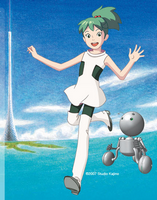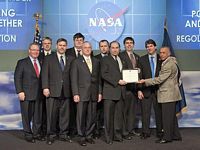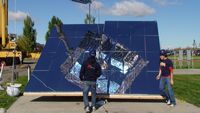 The latest post from Team LaserMotive shows their Climber’s first ascent at last year’s Space Elevator Games – Climber / Power-Beaming competition, complete with ‘appropriate music’…
The latest post from Team LaserMotive shows their Climber’s first ascent at last year’s Space Elevator Games – Climber / Power-Beaming competition, complete with ‘appropriate music’…
Monthly Archives: March 2010
Be wary of pushing buttons…
[youtube]http://www.youtube.com/watch?v=Km0xWsd0-As[/youtube]
.
View all of the episodes (they’re up to 26 episodes now!) here…
And, I just found a Tweet from Alex Koll (one of the four ‘climber-nauts’) which said about this episode “Season Finale”… Really? I’ll have to contact these guys again and see what’s what…
And, I’m sorry there’s been less-than-normal posting from me on this blog, but I have been very, very busy launching the various ISEC initiatives we’ve adopted for the year. We’ve received several abstracts already for the Artsutanov and Pearson prizes, we’re getting ready to issue a “Call for Papers” for the ISEC Journal, we’ve got artwork in process for the ISEC Posters, we have a Library project underway and the planning for the upcoming Space Elevator conference proceeds apace. We’ve had several new volunteers come on board and it takes time to get everyone up to speed.
I’ll be posting on all of this soon…
‘Nuff said…

A skeptical view of earth-based Space Elevators…
I’ve read several books by David Brin and enjoyed them all. This is the first time, however, I’ve seen a David Brin video (albeit a YouTube version).
He talks about future technologies, Space Shuttle fuel tanks representing a lost opportunity, tethers, solar sails and, briefly, Space Elevators. He’s a skeptic of the idea of an Earth-based Space Elevator (calling it a ‘far out what if’) but is more positive about putting one on Mars.
[youtube]http://www.youtube.com/watch?v=sG_xGzpSOfA[/youtube]
.
Some small nits;
- In his discussion of solar sails, he says that no one has tried to do this. However, the Planetary Society has tried once – and failed – and is getting ready to try again.
- He gives the impression that the taper on a space elevator has to continue increasing from the ground all the way out to the counterweight. If my understanding is correct, it only has to grow to GEO – from there the tether width can remain constant or even decrease.
A Japanese space elevator
 At the 2008 Space Elevator Conference, a large contingent arrived from Japan (I blogged about this here). One of the many items they brought and showed was a video/cartoon that had been created by some organization in Japan. I think they also brought this video to the 2007 Space Elevator games held near Salt Lake City in Utah. I have tried to get permission to show this in the US, but so far without success
At the 2008 Space Elevator Conference, a large contingent arrived from Japan (I blogged about this here). One of the many items they brought and showed was a video/cartoon that had been created by some organization in Japan. I think they also brought this video to the 2007 Space Elevator games held near Salt Lake City in Utah. I have tried to get permission to show this in the US, but so far without success
However, I did just find a website that is advertising this movie and, if you’re in Japan, you can go see it. The website is very cool, is bi-lingual (to flip it into English, just click on the ‘English’ button in the upper, right-hand corner of the webpage), and has a trailer of the movie.
Check out the Trailer and, as they have a contact form on their website, I will attempt to use this avenue to get permission to show this here in the US ?
Clubbing on the Space Elevator
At least the music is better than the elevators I’ve been on…
[youtube]http://www.youtube.com/watch?v=J29MglcYPpQ[/youtube]
.
Watch all of the adventures of our audacious explorers here…
Mr. LaserMotive goes to Washington…
 As I posted several days ago, a gathering was recently held in Washington DC – a gathering of NASA people involved in the Centennial Challenges program (of which the Space Elevator Games are a part) and most/all of the recent organizers and competitors from the recent competitions.
As I posted several days ago, a gathering was recently held in Washington DC – a gathering of NASA people involved in the Centennial Challenges program (of which the Space Elevator Games are a part) and most/all of the recent organizers and competitors from the recent competitions.
Team LaserMotive arrived in force and a post about the trip is now on their blog.
They have good things to say about the new direction of NASA and Ben Shelef, head of the Spaceward Foundation (organizers of the Space Elevator Games), agrees. Let’s hope everyone’s new-found optimism turns out to be correct…
(The picture is from the gathering and is of members of Team Lasermotive and several NASA personnel – visit the LaserMotive blog post to see a (slightly) larger version of this picture and several others)
Space Elevator Visions
 A few days ago, I linked to a YouTube video that featured Frank Chase, an artist out of Hilo, Hawaii. This video featured Frank and several of the space elevator-related animations and drawings he has created.
A few days ago, I linked to a YouTube video that featured Frank Chase, an artist out of Hilo, Hawaii. This video featured Frank and several of the space elevator-related animations and drawings he has created.
I’ve now gotten in touch with Frank and he pointed me to a couple of his websites where more of his work can be seen. The one which interests me the most, of course, is his “Space Elevator Visions” website – it has some very cool drawings and also some posters for sale – all of very high quality.
He also has another site, The Virtual Nautilus, with drawings “…established to showcase the Nautilus, as described by Jules Verne…”.
Check them out – I’m sure you’ll enjoy them.
Announcing the Artsutanov and Pearson awards
The International Space Elevator Consortium (ISEC) today announced the Artsutanov and Pearson awards; prizes intended to foster research into Space Elevator related topics.
The Press Release announcing these awards, sent out today, is copied below, in full:
================================
The International Space Elevator Consortium Announces the Pearson and Artsutanov Space Elevator Prizes
Mountain View, Calif. (March 3, 2010) — The International Space Elevator Consortium (ISEC), an independent group designed to promote standards and foster research relating to the construction of an Elevator to Space, has announced its first annual set of prizes, named after the co-inventors of the modern-day concept of the Space Elevator, Jerome Pearson and Yuri Artsutanov.
Formed in 2008 by a coalition of leaders in the Space Elevator movement, ISEC has established these prizes to encourage research into Space Elevator related technologies and concepts to help further ISEC’s mission of promoting “the development, construction and operation of a space elevator as a revolutionary and efficient way to space for all humanity“.
Ted Semon, the president of ISEC states; “We are thrilled to be able to offer these awards, named after the co-inventors of the modern-day concept of the Space Elevator. The Space Elevator, a ‘carbon railway’ to the solar system and beyond, is the right way to open up space to all humanity. With research into carbon nanotubes proceeding at an ever-accelerating rate, we think that it is only a matter of a few years before the material necessary to build a space elevator will be available. The time is now to begin serious planning for this most magnificent concept.”
Each year, ISEC selects a focal theme for its activities. For 2010, this theme is “Space Debris Mitigation“. One of the major hurdles that must be overcome in order to successfully build and operate a Space Elevator is avoiding space debris and satellites in orbit. While much research has been done on this topic, the goal for most existing research has been mitigating the problem of space debris in relation to satellites, the ISS, the Shuttle, etc.
The Pearson prize will be awarded for that paper which best addresses the topic of Space Debris Mitigation in relation to a Space Elevator and is open to all college undergraduate students currently enrolled in a two or four-year undergraduate curriculum.
The Artsutanov prize will be awarded for the best paper on any other Space Elevator-related topic and is open to everyone.
The winning paper of the Pearson prize will be awarded $1,500 while the winning paper of the Artsutanov prize will be awarded $2,500. Both winners will be invited to the 2010 Space Elevator conference (held this coming August in Redmond, Washington) to present their papers. Their papers will also be published in the ISEC Journal. In addition to awarding the prize money, ISEC will pay for airfare and hotel accommodations for the prize-winners (maximum of one per paper if multiple authors).
Contest details can be found on the ISEC website (www.isec.info).
For more details, please contact ISEC President Ted Semon (ted [at] isec.info), Prize Chair Peter Swan (peter [at] isec.info) or ISEC Technical Pillar Lead Ben Shelef (ben [at] isec.info).
Headquartered in Mountain View, Calif., a leading technology center, the International Space Elevator Consortium (ISEC) is a non-profit organization devoted to the research and construction of an Elevator to Space. Founding members of ISEC include the Spaceward Foundation, the Space Elevator Reference, the Space Elevator Blog, EuroSpaceward and the Japan Space Elevator Association. For more information please visit www.isec.info.
Press Inquiries:
Ted Semon
ISEC
1-630-240-4797
ted [at] isec.com
Belinda Young
BYPR
1-206-932-3145
byoung [at] bypr.com
================================
A copy of the Press Release, in PDF format, can be found here. I encourage all of you to send this to any email lists, websites, news organizations, etc. that you might have contact with. The more we can spread the news of this competition, the better.
As the Press release states, details and ‘the fine print’ can be found on the ISEC website. Come one, come all – do your research, send in your papers and maybe win some prize money and a trip to the Space Elevator Conference!
“One of the problems we had last year was wind-induced oscillation…”
 The Chicago Video Production company, Bitter Jester Creative, Inc., the “official video chronicler” of the Space Elevator Games, has some updated and some new video clips available. The sound is in stereo, too…
The Chicago Video Production company, Bitter Jester Creative, Inc., the “official video chronicler” of the Space Elevator Games, has some updated and some new video clips available. The sound is in stereo, too…
Check out this page to view them. All of them are of the very high quality that we have come to expect from this talented and dedicated group.
Nic DeGrazia, one of the members of this group, sent me this email about these clips:
Hello Elevator Boys!
I sent you the crane building vid for your enjoyment but I thought I’d let you know that I added that clip (with a nicer fade at the start) and two others (one that you’ve seen, where Ben explains the space elevator on the white board and another new one … UBC delicately polishing their solar cells before the wind whips their climber around) to the BJC site as well.
Check out this page on our new(!) website to see the clips in question…
-Nic
The title of this post was a quote from Ben Shelef (in the video clip ‘Building the crane‘) talking about how the redesign of the raceway would, hopefully, dampen the oscillations in the tether caused by the wind. Alas, this tether failed during the competition (described here and here) due to those pesky oscillations, and was a primary reason why Ben moved to a steel cable (which performed spectacularly well) in the 2009 Games. This was just one of those things that you don’t know if it’s going to work or not until you try it.
Watching these clips of the 2007 Games brought back a lot of memories – most of them good, but some of them sad. The weather really was a handicap in this event; lots of rain, lots of wind and even some snow and hail for good measure.

A new Space Elevator traveler…
We now have a new fellow-traveler in Space Elevator-land; Captain Casual. You can view his adventure (which he labels as Episode 1) below.
[youtube]http://www.youtube.com/watch?v=2MBJqGfAI0w[/youtube]
.
I think this has promise, but I’m not sure where the “700 miles of fullerene cable comes in” – a real space elevator would need to be about 60,000 miles long. Maybe we’ll find out in a future episode.
You know, we need to come up with a moniker for these guys (the ones at Elevator2Space and now Captain Casual).
‘Elevatornauts’ doesn’t roll off the tongue. Shortening it to ‘Vator-nauts’ sounds better but no one will know what you’re talking about.
‘Cable-nauts’ or ‘tether-nauts’?
As this is all comedy, maybe ‘Comic-nauts’ (like cosmonauts)?
If you have any suggestions, please send them in…
